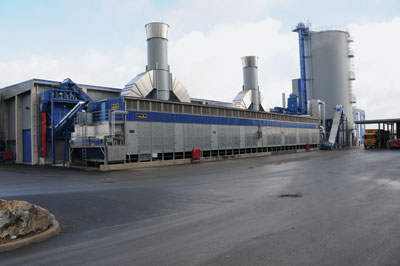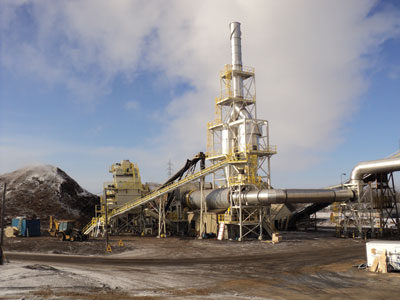
Choosing a Dryer
April 1, 2011
By Treena Hein
Although growth of the biomass energy sector here in North America has lagged behind that in jurisdictions such as Europe, new pellet mills, briquette mills, and combined heat and power (CHP) operations are sprouting up—and which dryer is chosen to remove moisture from the wood residue is critical.
Although growth of the biomass energy sector here in North America has lagged behind that in jurisdictions such as Europe, new pellet mills, briquette mills, and combined heat and power (CHP) operations are sprouting up—and which dryer is chosen to remove moisture from the wood residue is critical.
 |
|
| A belt dryer like this one is being fabricated in Germany to dry wood biomass for the University of British Columbia’s combined heat and power gasification system. This dryer, installed at a German pellet plant in Erndtebrück, uses a hot-water heat source at 105oC and has a water evaporation capacity of 14 tonnes/hour of water. Photo: Stela
|
The choice of drying technology is greatly dependent on the customer’s situation and the available heat source, says Dirk Koltze, a spokesperson for Büttner, which has sold many units for drying wood residue in North America. “A dryer manufacturer should offer the most efficient and cost-effective dryer technology customized for the particular situation,” he says. “For example, if the heat source is low quality (such as hot water at 70º to 100ºC, low-temperature exhaust boiler gases, or low-pressure steam at 10 to 30 PSI), ultra-low-temperature belt dryers are recommended. Such dryers compensate the low calorific value of the heat with relatively large air flows to generate the required energy for drying.”
For higher quality heat sources (such as medium-pressure saturated steam at 70 to 230 PSI or thermal oil in the range of 150º to 300ºC), indirect heated dryers are the best choice, says Koltze. “This type of dryer is often utilized in cogeneration plants as a condenser for saturated steam coming off a turbine,” he observes. “This ‘waste’ heat stream is a very efficient and economical way for drying biomass.” Wood biomass is dried in a stationary housing that contains a rotating heat exchanger, in Büttner’s indirect heated dryers, with the heat transfer through contact and mechanical transport of the biomass. “This set-up means that exhaust air volumes are very limited, significantly reducing the need for air cleaning equipment.”
For high-quality heat sources such as flue gas from suspension burners or grate-fired systems, the company offers single-path, direct-heated rotary drum dryers. “Here, flue gases ranging in temperature between 200º and 1000ºC are utilized to dry the biomass,” says Koltze.
In Europe, harnessing the synergies of CHP and pellet or briquette production is a common practice, notes Simon Staufer, sales director for Switzerland-based Swiss Combi. “The belt dryer is the link between the two processes,” he says. “It utilizes the waste heat from power production to dry the biomass and therefore increases the heating value and standardizes the properties of the biomass.” Swiss Combi’s belt dryer uses low-temperature waste heat to dry product on a porous belt in an enclosed area. None have yet been installed for wood residue use in Canada or the United States. “Our belt dryers are high-efficiency dryers and, like our ‘ecoDry’ rotary dryer, provide gentle drying and a low risk of fire and explosion,” says Staufer. They also offer automated operation, low maintenance costs, and long intervals between cleaning. Because the product bed acts as a filter, the dryers also produce low emissions.
The ecoDry uses indirect heat via a closed superheated steam loop and an integrated thermal oxidizer. “Due to the separation of the energy generation and the drying process, exhaust gas volume is considerably reduced compared to other rotary drum dryers,” says Staufer. Evaporated water and emissions are bled off from the closed loop and fed into the combustion chamber, where high temperatures oxidize and reduce odours, dust, VOCs (volatile organic compounds) and carbon monoxide. Although the ecoDry requires a similar investment to a direct heated drum dryer, Staufer says it provides a faster return on investment. Swiss Combi hasn’t yet sold an ecoDry unit in North America for the purpose of drying wood biomass, but has sold about 10 here for drying other materials.
Andritz is another major company that has yet to break into the North American market in terms of dryers handling wood residue (the firm sells drum, pneumatic, and belt dryers), but spokesperson Joanne Turnell says they recently sold the belt dryers installed at the world’s largest pellet plant in Vyborg, Russia. Constructed by pulp and paper producer Vyborgskaja Cellulosa, the facility will have the capacity to produce 125 tons/hour of pellets. Other equipment for the plant is also being provided by Andritz, including a chip handling system, debarking lines, hammermills, and pellet mills.
Kahl is also keen to make the first North American sale of its fabric belt dryers. “The product is turned over in the dryer so that a very uniform final moisture content is obtained,” says Rick MacArthur, president of Kahl distributor Sarj Equipment in Bradford, Ontario. “At the same time that the tightly woven plastic fabric belt moves product along, it also filters dust, odour, and VOCs from the exhaust air.”
In the Bruks bed dryer, material is passed into the dryer by a spreading screw and onto a smooth loading zone plate without holes. The mat of material is then moved to a punched plate, where air passes through holes from below into the mat. Moisture migrates out the top of the mat with the air, and at the end of the process, a skimming screw is used to scrape off the moist upper layer of material, so that only the properly dried material is discharged. A moisture sensor is used to control the depth of cut of the skimming screw. Bruks has yet to sell a bed dryer in Canada or the United States.
Rotary dryers at work
Steve Walker, owner of 18-year-old New England Wood Pellets in Jaffrey, New Hampshire, chose M-E-C rotary drum dryers for all three of his facilities. “Drum dryers are better if you’re creating your own heat on site, which we do using a furnace,” opines Walker. He chose drum dryer technology because it’s also well proven. “M-E-C is well established, and a good reputation was very important to us.” The raw materials for New England pellets come from sawmills and low-grade logs, as well as from furniture and flooring mills. Most pellets are sold for the domestic residential heating market.
 |
|
| The direct-heated rotary drum dryer at Société de Cogénération de Saint-Félicien in Saint-Félicien, Quebec, uses hot exhaust from the biomass boiler to pre-dry its own hog fuel. Photo: Büttner
|
At the privately owned Société de Cogénération de Saint-Félicien in Saint-Félicien, Quebec (a subsidiary of Enel Green Power North America), they chose a Büttner rotary drum dryer. When asked how they came to this decision, plant manager Marc Poirier says, “We did quite a bit of research, and at the end of this process, we approached a good number of global drying machine manufacturers and asked them if they’d like to participate in providing a turnkey operation.” Eight companies initially replied, and discussions continued with six of them. Four firms subsequently provided bids: two for belt drying systems and two for rotary drum systems. “The bids included information on cost, efficiency, capacity, and also the companies’ histories and information on similar projects that they had participated in,” says Poirier. “We decided on Büttner because they provided the best system for the price, they have a solid reputation, a long history, and had completed projects of a similar nature.” The rotary drum dryer uses boiler exhaust gases as a heat source, and the boiler receives equal amounts of dried material and wetter material that comes directly from sawmill operations. “Drying using this loop system substantially pre-heats and dries the bark, allowing us to save a lot of bark and optimize electricity production,” says Poirier. “We sell steam to a local sawmill for drying lumber and generate electricity to sell to the grid.”
A Baker-Rullman rotary drum dryer was the choice for the pellet mill at H.J. Crabbe & Sons, a long-established lumber operation in Bristol, New Brunswick. “It’s the least expensive system, and this type of dryer has been around a long time,” says owner Don Crabbe. “Baker-Rullman has a really good reputation, and they’ve done everything they’ve said they were going to do, so it’s worked out very well.” Pellet production began about a year ago but has been halted due to a current overabundance on the market. Crabbe says he will start the pellet mill up again later in 2011.
Belt dryer for large BC project
If low-temperature waste heat is available from a CHP system—such as the innovative woody biomass CHP system being constructed at the University of British Columbia (UBC) in Vancouver—and no primary energy is needed, belt dryers are the best choice in comparison to drum dryers, says Tobias Latein, spokesperson for Germany-based Stela. “The low temperature means there is no VOC in the exhaust, whereas the high temperature required for a drum dryer creates VOC,” he notes. “The fire danger is low due to a low exhaust temperature, and the low temperature also keeps lignin intact.” Lignin is needed as “glue” for the pelleting process (if pellets are being produced), but some of it is evaporated in a drum dryer due to the higher temperature. In addition, the Stela belt is designed as a filter, so there is no exhaust air cleaning necessary. However, Latein says that because belt dryers are much larger than drum dryers because of the necessity of higher air flow with the lower temperature, they are somewhat more expensive.
In the last seven years, Stela has installed about 90 belt dryers for biomass drying in Europe. Its first Canadian sale was to Nexterra Systems, the biomass gasification company overseeing the supply and installation of UBC’s CHP system. The system is expected to be operational in early 2012. Nexterra’s vice president of projects, Goran Sparica, says a Stela belt dryer was chosen because the company has a well-established reputation with these types of systems. This specific dryer was also attractive because its particulate emissions levels are well below the current provincial standards. “The low-temperature drying using high-capacity hot water heat exchangers will reduce the moisture content in the wood residue from 50% to 20–25%,” Sparica says. “The dried material will be conveyed to the gasifier, which produces syngas. The syngas will be used to fire an internal combustion engine that will produce 2 MW of electricity and will also be used to produce steam for use by UBC.” About 30% of the woody biomass will be tree and hedge trimmings donated by the City of Vancouver; the rest will be urban wood waste sourced from local fuel aggregators.
Although the slow growth of the wood biomass energy sector in North America can be trying, companies that have yet to make a North American sale for this purpose are staying positive. “We feel using woody biomass for energy will see a long-term trend upwards,” says Kahl distributor MacArthur. “We have quality products to offer and are ready to provide the expertise and experience we’ve garnered from other uses and jurisdictions.” MacArthur would like Canada to learn from the successful European model, where drying facilities are located close to heat sources such power plants, institutions, and large commercial operations. “With access to heat sources such as steam and hot water, the viability of belt dryers can have a dramatic advantage environmentally and economically,” he says. “The Europeans are years ahead of us when it comes to these technologies, and I see us playing catch-up over the next number of years.”